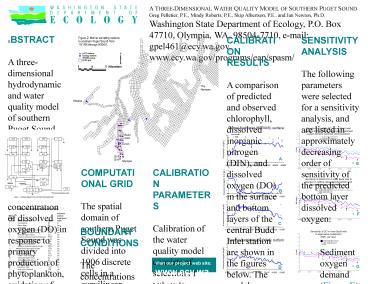A THREEDIMENSIONAL WATER QUALITY MODEL OF SOUTHERN PUGET SOUND - PowerPoint PPT Presentation
1 / 1
Title:
A THREEDIMENSIONAL WATER QUALITY MODEL OF SOUTHERN PUGET SOUND
Description:
A THREE-DIMENSIONAL WATER QUALITY MODEL OF SOUTHERN PUGET SOUND ... The water quality model simulates the concentration of dissolved oxygen (DO) in ... – PowerPoint PPT presentation
Number of Views:69
Avg rating:3.0/5.0
Title: A THREEDIMENSIONAL WATER QUALITY MODEL OF SOUTHERN PUGET SOUND
1
A THREE-DIMENSIONAL WATER QUALITY MODEL OF
SOUTHERN PUGET SOUND Greg Pelletier, P.E., Mindy
Roberts, P.E., Skip Albertson, P.E., and Jan
Newton, Ph.D. Washington State Department of
Ecology, P.O. Box 47710, Olympia, WA, 98504-7710,
e-mail gpel461_at_ecy.wa.gov, www.ecy.wa.gov/program
s/eap/spasm/
ABSTRACT A three-dimensional hydrodynamic and
water quality model of southern Puget Sound was
developed based on the EFDC model. The water
quality model simulates the concentration of
dissolved oxygen (DO) in response to primary
production of phytoplankton, oxidation of organic
material, and sediment flux (Figure 1 and Table
1). Of the 22 possible state variables in EFDC,
the model of southern Puget Sound includes two
phytoplankton groups, three forms of organic
carbon, three forms of organic phosphorus and
nitrogen, dissolved reactive phosphorus, ammonia
nitrogen, nitrate plus nitrite nitrogen, chemical
oxygen demand, and dissolved oxygen. Fecal
coliform was also included. A sediment process
model is coupled with the water column model. The
sediment model incorporates three processes
depositional flux of particulate organic matter
(POM), diagenesis of POM, and the resulting
sediment flux. The model was calibrated to
limited data collected between October 1996 and
September 1997. Because of the relative scarcity
of data, the model is only crudely calibrated at
the present time.
CALIBRATION RESULTS A comparison of predicted
and observed chlorophyll, dissolved inorganic
nitrogen (DIN), and dissolved oxygen (DO) in the
surface and bottom layers of the central Budd
Inlet station are shown in the figures below. The
model runs presented below used the entire grid
of southern Puget Sound. In general, the model
describes many of the seasonal patterns of the
observed data. In the surface layer (Figures
A-C), chlorophyll increased during the
April-September season. Concentrations of DIN
were predicted to decline during the same period,
which is consistent with observed patterns caused
by uptake of nutrients by algae. The model did
a good job of predicting DO in the bottom layer
of the central part of Budd Inlet (Figure D). DO
in the bottom layer of the inner inlet was
over-predicted (Figures E-G). A sensitivity
analysis was performed to determine which factors
could improve calibration of DO in the inner
inlet.
- SENSITIVITY ANALYSIS
- The following parameters were selected for a
sensitivity analysis, and are listed in
approximately decreasing order of sensitivity of
the predicted bottom layer dissolved oxygen - Sediment oxygen demand (Figure E)
- Settling rates (Figure F)
- Algal basal metabolism rates (Figure G)
- Maximum algal growth rates
- Zooplankton algal predation rates
- Nitrogen half-saturation
- Calibration of the sediment model will be very
important. Sediment flux and concentration data
for southern Puget Sound are either very limited
or nonexistent in most areas of southern Puget
Sound, so this is an important data requirement
for refinement of the calibration. - Field studies for other key parameters,
especially settling rates for phytoplankton and
particulate organic matter, and algal basal
metabolism rates would also be useful for further
refinement of the model calibration.
Central Budd Inlet (BUD005), surface
A
E
COMPUTATIONAL GRID The spatial domain of
southern Puget Sound was divided into 1906
discrete cells in a curvilinear orthogonal grid
(Figure 2). The average grid cell is
approximately 630 by 630 meters. Each grid cell
has four vertical layers in the stretched-sigma
coordinate system used by the EFDC model. The
mass balance equations in the EFDC model are
solved using the finite-difference method. The
portion of the computational grid that
represented Budd Inlet was extracted from the
full grid to create a separate sub-model of Budd
Inlet. This was done to facilitate model
calibration using data from Budd Inlet.
CALIBRATION PARAMETERS Calibration of the water
quality model consists of selection of values to
represent the kinetics and constants of the model
equations. Two sets of parameters were evaluated
for the model of southern Puget Sound. The first
set is the selected calibration parameters for
representation of Chesapeake Bay and the Peconic
estuary (Cerco and Cole, 1994, Tetra Tech, 1998).
The second set of parameters that were considered
was developed for a modeling study of Budd Inlet
(LOTT, 1999 Boatman and Edinger, 1999). The
status of calibration of the EFDC model to
southern Puget Sound consists of a comparison of
the model results with observed concentrations
using the two sets of model parameters, and a
sensitivity analysis of model predictions for
various ranges of key parameters.
B
F
C
BOUNDARY CONDITIONS The concentrations of water
quality state variables at the saltwater boundary
of the model grid are referred to as boundary
conditions. Salinity, temperature, algae, organic
carbon, dissolved oxygen, nitrogen, phosphorus,
and fecal coliform bacteria were specified based
on monitoring data collected near the open
boundaries for the simulation period of 10/1/96
through 9/30/97. The freshwater inflows and
loads to the model domain were characterized for
the same period as described by Roberts et al. in
a separate paper for this conference.
Central Budd Inlet (BUD005), bottom
Visit our project web site www.ecy.wa.gov/program
s/eap/sps/
G
D































